Fabrics
Description of the materials that Gepur uses in the production of women's clothing
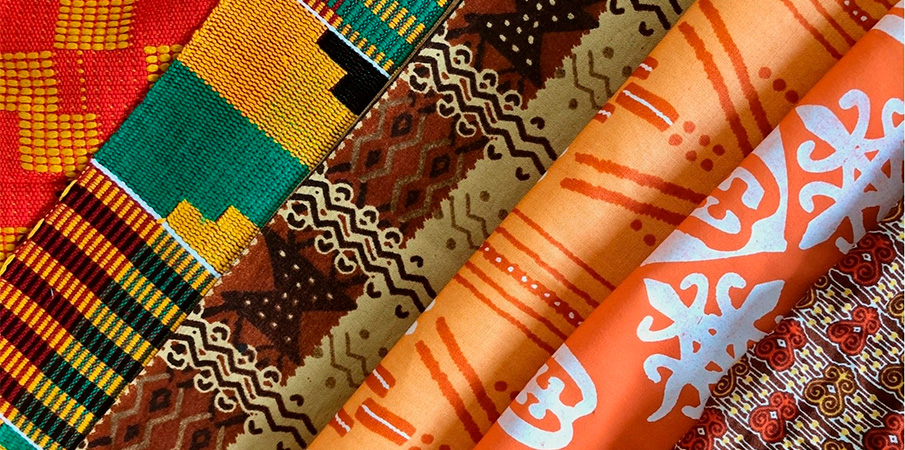
In the world of fashion, where style and individuality become part of the everyday look, choosing the right fabric plays an important role. From the soft embrace of silk to the signature denim, each fabric brings unique properties, adding its own nuance to the visual and tactile experience of a garment. In this article we will dive into the wonderful world of fabrics used in the production of women's fashionable clothing. We will understand the features of each material, explore their properties, and also find out how the right choice of fabric will emphasize style and add comfort to your look.
Classification of fabrics for women's clothing
There are many ways to classify women's clothing fabrics, but the most common way is by fiber type.
By fiber composition:
- Natural: cotton, linen, silk, wool.
- Artificial: viscose, polyester.
- Synthetic: polyester, nylon, acrylic.
By texture and texture:
- Smooth fabrics: chiffon, silk, satin.
- Embossed fabrics: velvet, corduroy, knitted materials.
By purpose:
- Everyday fabrics: denim, velor.
- Evening fabrics: satin, silk, shiny and shimmering materials.
- Sports fabrics: lycra, elastane, technological materials.
By seasonality:
- Summer fabrics: linen, silk.
- Winter fabrics: wool, cashmere, plush.
By structure:
- Fabrics with finishing: lace, stitching, embroidery, appliqués.
- Thick fabrics: flannel, denim.
- Thin and transparent fabrics: organza, tulle.
What kind of fabric is cotton?
Cotton is a natural fiber obtained from cotton seeds. It is a soft, breathable and absorbent fiber that is used to make various types of clothing, home textiles and other products.

Cotton properties:
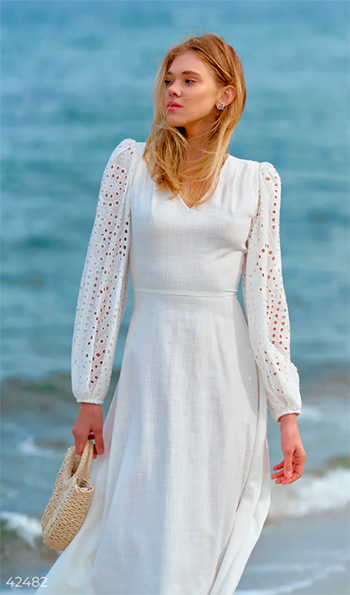
- Softness: Cotton is a soft fiber that is pleasant to the body. This makes it an ideal choice for clothing that needs to come into contact with the skin, such as T-shirts, underwear and pajamas.
- Breathability: Cotton is a breathable fiber that allows air to circulate. This makes it an ideal choice for hot weather clothing.
- Hygroscopic: Cotton is a hygroscopic fiber that absorbs moisture. This makes it an ideal choice for towels, robes and other absorbent clothing.
- Durability: Cotton is a durable fiber that can withstand wear and tear. This makes it an ideal choice for clothes that need to be durable, such as jeans and shirts.
- Durability: Cotton is a durable fiber that can be machine washed and dried. This makes it easy to care for.
- Hypoallergenic: Cotton is a hypoallergenic fiber, which means it is unlikely to cause an allergic reaction. This makes it an ideal choice for people with sensitive skin.
- Eco-friendly: Cotton is a biodegradable fiber that is environmentally friendly. This makes it an eco-friendly choice.
What things are made from cotton?
Many types of women's clothing are made from cotton. Here are popular options:
- Dresses
- Shorts
What kind of fabric is linen
Linen is a natural fabric made from the fibers of flax, a plant grown in cool climates. Linen is valued for its strength, durability, breathability and hygroscopicity.

Properties of flax:
- Durability: Linen is one of the most durable natural fabrics. It is tear and abrasion resistant, making it ideal for clothing that needs to be durable, such as jeans and shirts.
- Durability: Linen is a durable fabric that can withstand repeated washings. It does not deform and does not lose color over time.
- Breathability: Linen is a breathable fabric that allows air to circulate. This makes it ideal for hot weather wear.
- Hypoallergenic: Linen is a hypoallergenic fabric, meaning it is unlikely to cause an allergic reaction. This makes it an ideal choice for people with sensitive skin.
- Environmental friendliness: Linen is an environmentally friendly material. Its production requires less water and pesticides than other natural fabrics such as cotton.
What women's clothes are made from linen?
- Jackets are a stylish and practical option for summer weather.
- Dresses and sundresses are a must-have in every woman’s wardrobe for the summer. They come in different styles and colors. This is a comfortable and stylish option for hot weather.
- Pants are a stylish option for everyday wear.
- Shorts are a practical option for summer holidays.
- Blouses are a feminine and stylish option for any woman.
Satin fabric

Satin is a cotton fabric that has a special thread weaving structure that gives it a characteristic shine and smoothness.

Properties of satin:
- Smoothness and silkiness: The front side of the satin has a smooth, silky surface, pleasant to the touch.
- Shine: Satin has a characteristic shine that gives it a noble appearance.
- Durability: Satin is a fairly durable fabric that can withstand repeated washing.
- Does not electrify: Satin does not electrify, which makes it comfortable to wear.
- Easy care: Satin is easy to wash and iron.
What kinds of things are made from satin?
Satin is a beautiful, practical and comfortable fabric. Many women's clothes are sewn from satin, here are some of them:
Dresses:
- Satin dresses are a must-have in every woman’s wardrobe. They come in a variety of styles and colors, so you can find the perfect dress for every body shape.
- Summer sundresses: Satin makes light and flowy sundresses, ideal for hot weather.
- Evening dresses: Satin is a luxurious fabric from which you can create spectacular evening dresses.
Blouses and shirts:
- Satin blouses are a feminine and stylish option for any woman.
- Satin shirts are a versatile wardrobe item that can be worn both to work and going out.
Pants and skirts:
- Satin trousers are a stylish and practical option for everyday wear.
- Satin skirts are a feminine and versatile wardrobe item that can be dressed up or down.
Crepe nylon

Crepe nylon is a dense, rigid fabric, resistant to damage, weightless, holds its shape well, and does not stretch. The fabric washes well from dirt. It is recommended to wash in cold water on short cycles. White nylon can be bleached with non-chlorine products if necessary.
Properties of crepe nylon fabric:
- Durability: Crepe nylon is very strong and durable. It can withstand repeated washing and does not deform.
- Lightweight: Crepe nylon is very lightweight, making it ideal for comfortable, lightweight clothing.
- Abrasion Resistance: Crepe nylon is abrasion resistant. Ideal for clothing and shoes subject to frequent friction.
- It does not require special care. It can be machine washed in cold or warm water and then hung or tumble dried.
- Crepe nylon is suitable for making a variety of products, from clothing and shoes to bags and accessories:
What is crepe nylon made from?
- Cloth. Crepe nylon is often used to make clothing such as dresses, skirts, trousers and jackets. It is also used to make sportswear such as T-shirts, shorts and leggings.
- Bags and Accessories: Crepe nylon is often used to make accessories such as bags, briefcases, wallets and belts.
Knitwear Otto - what is it
Otto knitted fabric (also known as ottoman) is a type of knitted fabric that differs in its structure and properties. Otto has a special weave that combines knit and purl stitches to create a distinctive ribbed surface. Otto comes in a variety of densities, from light to thicker.

Otto properties:
- Durability: Otto is a fairly strong and wear-resistant fabric.
- Elasticity: Otto has good stretch for a comfortable fit.
- Thermal Insulation: Otto retains heat well, making it ideal for cold weather.
- Wrinkle-resistant: Otto is virtually wrinkle-resistant, making it easy to care for.
- Easy care: Otto is easy to wash and iron.
What is denim material?
Denim is the name of the fabric from which jeans, jackets, shirts and other items of clothing are made. Denim and denim are essentially the same thing. Denim is the common name for denim and is most often used colloquially. Denim fabric is made from woven threads that are arranged in a special pattern, giving it a weave pattern. Denim is typically blue or indigo, although other darker shades can also be found.

Denim properties:
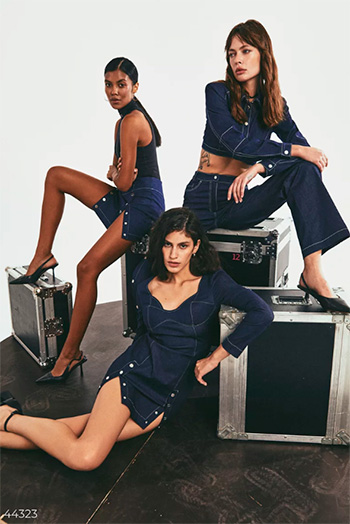
- Durability: Denim is very durable and hard-wearing, making it ideal for casual wear.
- Breathable: Thanks to its natural base, denim is highly breathable, making it comfortable to wear.
- Versatility: Denim is suitable for a wide variety of garments, from jeans and jackets to shirts and dresses.
- Style: Denim has its own unique style, which combines practicality and rebellious spirit.
What kind of things are made from denim?
Many women's clothes are made from denim, here are some of them:
Outerwear
- Denim jackets are a classic that never goes out of style. They can be of different styles: short, long, with a hood, with a fur collar, etc.
- Vests are a stylish and practical wardrobe item.
- Denim dresses are a comfortable and versatile option for a summer wardrobe.
- Denim shirts are a must-have in every fashionista's wardrobe.
Underwear
- Jeans are the most popular denim clothing.
- Denim shorts are a great option for a summer vacation.
- Denim skirts are a stylish and feminine element of your wardrobe.
Accessories
- Bags: Denim bags are a stylish and practical accessory.
- Belts: Denim belts are a versatile accessory that goes with any outfit.
- Shoes: Denim is also used to make shoes, such as sneakers, sneakers, and boots.
Three-thread
Three-thread is a type of knitted fabric that consists of three threads connected to each other in a special way.

Types of three threads:
- Brushed: Features a looped brushed inner layer that provides additional insulation.
- Fleece: Has an inner layer of fleece, which further increases the thermal insulation properties of the fabric.
- Without combing: It does not have internal combing, so it is lighter and suitable for demi-season clothing.
Properties of three threads:
- Density: 190-360 g/m². This makes the fabric quite warm and wear-resistant.
- Thermal insulation: Thanks to its density and internal fleece layer, three-thread retains heat well.
- Elasticity: The three-thread fabric has good stretch, which ensures comfortable wearing.
- Breathability: Despite the density, the three-thread allows air to pass through well.
- Wear resistance: Clothing made from three threads lasts a long time, does not deform and does not fade.
Application of three threads:
- Sportswear: suits, sweatshirts, hoodie, shorts.
- Clothes for home: pajamas, dressing gowns.
- Leisure wear: Joggers, dresses, T-shirts.
Silk
Rayon is a man-made material that imitates the texture and appearance of natural silk, but is produced using chemical processes and synthetic fibers rather than from insect cocoons. Rayon is also known as regenerated silk or pieced silk.

There are several types of rayon, including rayon, modal and lyocell. They have different properties, but what they have in common is that they are created by converting natural polymers, such as cellulose from wood, into fibers.
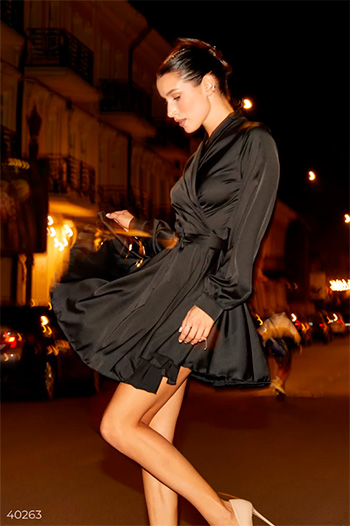
- Viscose: This is the most common type of rayon and is made from wood pulp.
- Modal: This type of rayon is made from eucalyptus cellulose and has higher strength and hygroscopicity than viscose.
- Lyocell: This type of rayon is made from wood pulp using gentle processes, making it more environmentally friendly than viscose.
Properties of artificial silk:
- Appearance: Rayon has a luster and smoothness similar to natural silk, giving it a beautiful and sophisticated appearance.
- Drapability: Like natural silk, rayon drapes well, creating beautiful folds and graceful silhouettes.
- Durability: Rayon is more durable than real silk, making it more resistant to wear and tear.
- Cost: Artificial silk is usually cheaper than natural silk, which makes it more affordable.
Artificial silk is used for sewing:
- Clothes: silk dresses, blouses, trousers, suits
- Accessories: scarves, shawls, ties, stoles
What kind of fabric is the stitching?
Natural thin fabric, most often plain with perforated embroidery, reminiscent of openwork sewing. It allows air to pass through well, making it ideal for lightweight summer items. Requires delicate machine or hand wash.

Sewing properties:
- Naturalness: The stitching is made from natural cotton fibers, which makes it breathable, comfortable and hypoallergenic.
- Lightness: Stitching is a light and airy fabric, ideal for summer clothing.
- Aesthetics: The openwork embroidery of the stitching gives it an elegant and feminine look.
- Practicality: The stitching is quite strong and wear-resistant, does not fade or deform if properly cared for.
- Breathability: The stitching allows air to pass through well, providing a comfortable microclimate for the body.
Stitching is used for sewing:
- Clothes: dresses, blouses, sundresses, skirts, trousers, etc.
- Home textiles: tablecloths, napkins, curtains, lambrequins, etc.
- Interior items: bedspreads, pillows, panels, etc.
Faux leather
Faux leather is a material created to imitate natural leather. Faux leather is also known as eco-leather or synthetic leather. Its production may include various synthetic materials such as polyurethane, polyvinyl chloride (PVC) or polyester.

Properties of artificial leather:
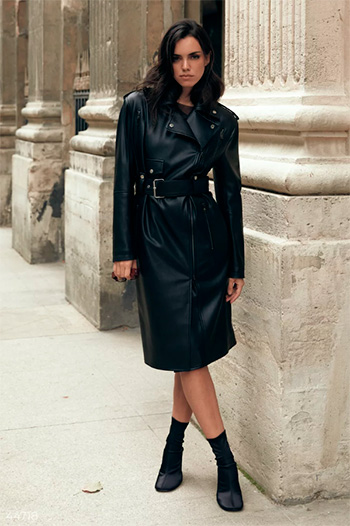
- Variety: Faux leather is available in a wide range of colors, textures and thicknesses, allowing you to choose the material for different purposes.
- Affordability: Faux leather is usually much cheaper than natural leather.
- Practicality: Artificial leather does not require complex care, is easy to clean and does not deform.
- Durability: Modern types of faux leather can be very durable and abrasion resistant.
- Environmental friendliness: The production of artificial leather is generally less harmful to the environment than the production of natural leather.
Application of artificial leather:
- Clothing production: jackets, raincoats, trousers, skirts, shoes, bags, belts, hats
- Production of haberdashery: bags, suitcases, purses, covers
